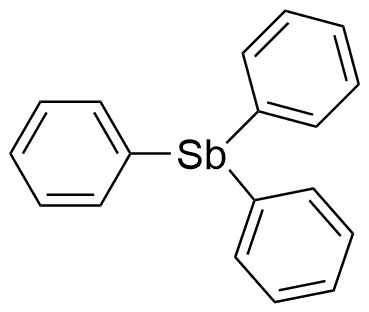Triphenylantimony is widely utilized in research focused on:
- Organometallic Chemistry: It serves as a precursor for various organometallic compounds, facilitating the study of metal-ligand interactions and the development of new catalysts.
- Pharmaceutical Development: Its derivatives are explored for potential applications in drug formulation, particularly in targeting specific biological pathways, enhancing efficacy, and reducing side effects.
- Materials Science: Used in the synthesis of advanced materials, including polymers and nanomaterials, triphenylantimony contributes to the development of high-performance coatings and electronic devices.
- Environmental Chemistry: It plays a role in the study of heavy metal contamination and remediation strategies, helping researchers understand the behavior of antimony in various environmental contexts.
- Analytical Chemistry: Employed as a reagent in various analytical techniques, it aids in the detection and quantification of other compounds, enhancing the accuracy of chemical analyses.
General Information
Properties
Safety and Regulations
Applications
Triphenylantimony is widely utilized in research focused on:
- Organometallic Chemistry: It serves as a precursor for various organometallic compounds, facilitating the study of metal-ligand interactions and the development of new catalysts.
- Pharmaceutical Development: Its derivatives are explored for potential applications in drug formulation, particularly in targeting specific biological pathways, enhancing efficacy, and reducing side effects.
- Materials Science: Used in the synthesis of advanced materials, including polymers and nanomaterials, triphenylantimony contributes to the development of high-performance coatings and electronic devices.
- Environmental Chemistry: It plays a role in the study of heavy metal contamination and remediation strategies, helping researchers understand the behavior of antimony in various environmental contexts.
- Analytical Chemistry: Employed as a reagent in various analytical techniques, it aids in the detection and quantification of other compounds, enhancing the accuracy of chemical analyses.
Documents
Safety Data Sheets (SDS)
The SDS provides comprehensive safety information on handling, storage, and disposal of the product.
Product Specification (PS)
The PS provides a comprehensive breakdown of the product’s properties, including chemical composition, physical state, purity, and storage requirements. It also details acceptable quality ranges and the product's intended applications.
Certificates of Analysis (COA)
Search for Certificates of Analysis (COA) by entering the products Lot Number. Lot and Batch Numbers can be found on a product’s label following the words ‘Lot’ or ‘Batch’.
*Catalog Number
*Lot Number
Certificates Of Origin (COO)
This COO confirms the country where the product was manufactured, and also details the materials and components used in it and whether it is derived from natural, synthetic, or other specific sources. This certificate may be required for customs, trade, and regulatory compliance.
*Catalog Number
*Lot Number
Safety Data Sheets (SDS)
The SDS provides comprehensive safety information on handling, storage, and disposal of the product.
DownloadProduct Specification (PS)
The PS provides a comprehensive breakdown of the product’s properties, including chemical composition, physical state, purity, and storage requirements. It also details acceptable quality ranges and the product's intended applications.
DownloadCertificates of Analysis (COA)
Search for Certificates of Analysis (COA) by entering the products Lot Number. Lot and Batch Numbers can be found on a product’s label following the words ‘Lot’ or ‘Batch’.
*Catalog Number
*Lot Number
Certificates Of Origin (COO)
This COO confirms the country where the product was manufactured, and also details the materials and components used in it and whether it is derived from natural, synthetic, or other specific sources. This certificate may be required for customs, trade, and regulatory compliance.


